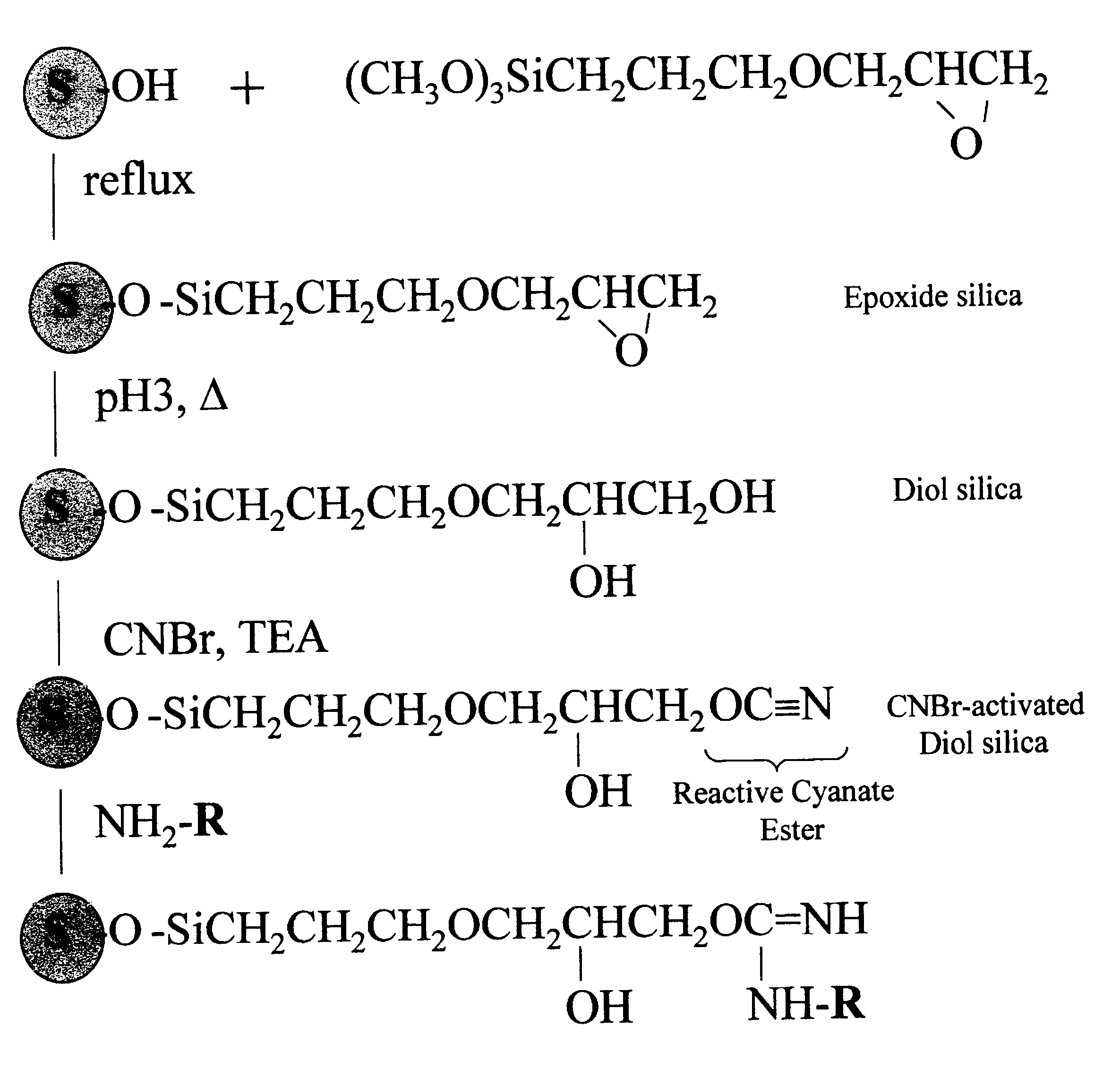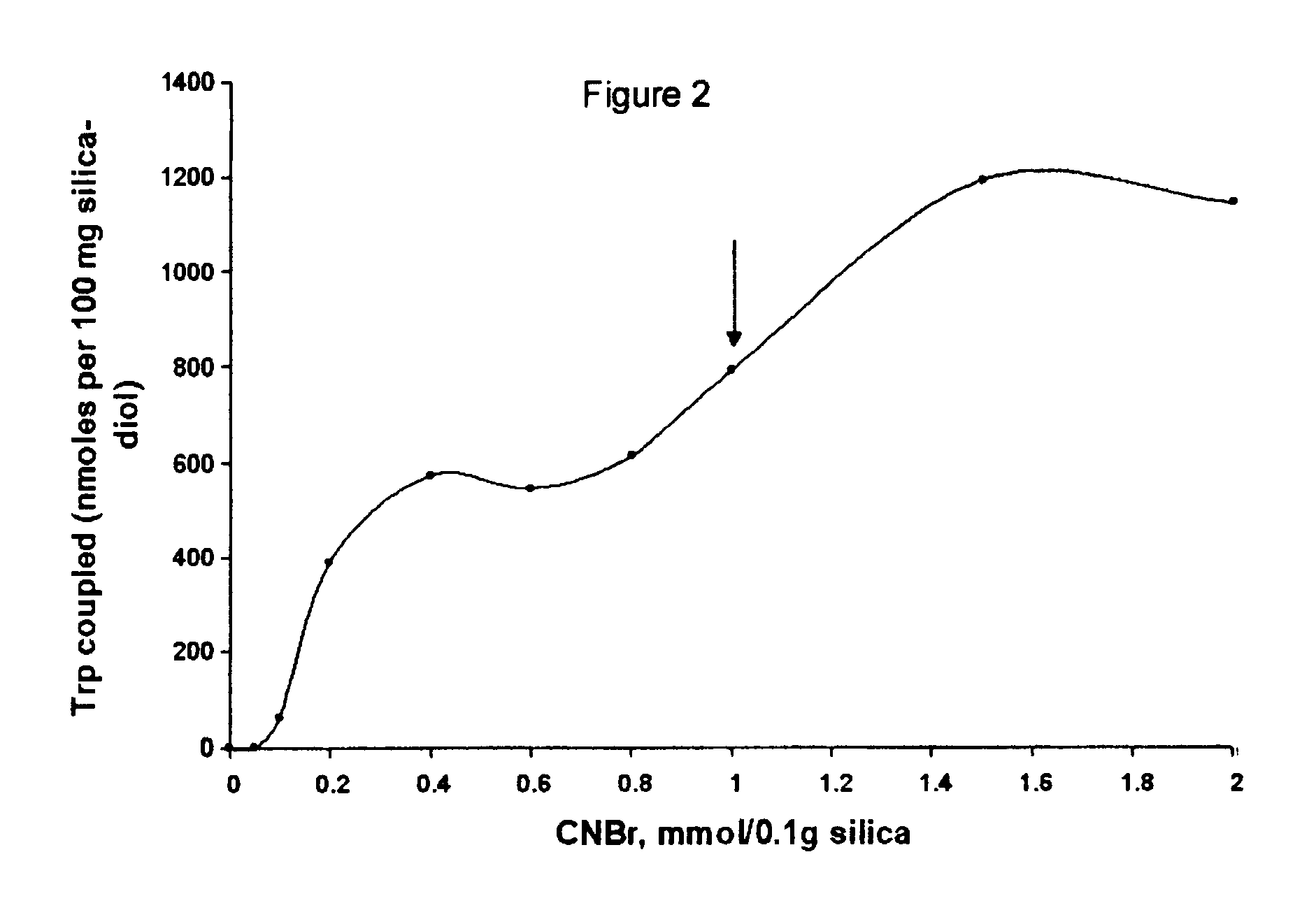Cyanogen bromide-activation of hydroxyls on silica for high pressure affinity chromatography
a technology of cyanogen bromide and affinity chromatography, which is applied in the direction of other chemical processes, instruments, separation processes, etc., can solve the problems of insufficient chromatographic resolution, insufficient operating pressure to maintain a certain flow rate increase, and chemistries that have reacted only slowly or in poor yield
- Summary
- Abstract
- Description
- Claims
- Application Information
AI Technical Summary
Benefits of technology
Problems solved by technology
Method used
Image
Examples
example 2
Activation of Diol-silica
One gram of diol-silica (50 .mu.m bead, 300 .ANG. pore prepared from Machery-Nagel Polygoprep as described in Example 1) was suspended in 5 ml anhydrous acetone in a thick walled plastic tube. A vacuum was applied and the tube was immersed in a bath-type sonifier and sonicated for 5 min. The suspension was transferred to a 50 ml beaker and excess acetone was removed to leave an easily mixable slurry. This, and all necessary reagents, were immersed in a methanol bath and small chips of dry ice (solid CO.sub.2) added until the temperature was a constant -15.degree. C. One ml of 1 M CNBr (1 mmole) in anhydrous acetone was added and the beaker swirled to mix. A timer was started and 1 ml of 1.5 M triethylamine in anhydrous acetone was added dropwise over a 3 min. time period while swirling the beaker. The reaction mixture was then rapidly filtered on a sintered glass filter funnel and the silica washed with 50 ml ice cold (0.degree. C.) acetone, 50 ml ice cold w...
example 3
Coupling pH and pH Stability
Tryptophan was coupled by adding a portion of the activated, semi-dried cake from Example 2 containing 0.1 g. silica to 0.5 ml of 10 mM tryptophan (5 .mu.mol) in coupling buffer (0.1 M NaHCO.sub.3, pH 8.3, 0.5 M NaCl). This was mixed by tumbling overnight at 20.degree. C. The next day, the silica was washed thoroughly with coupling buffer (0.1 M NaHCO.sub.3, pH 8.3, 0.5 M NaCl) and the washes recovered. The amount of tryptophan in the washes was quantified by absorption of 272 nm ultraviolet light. By difference we found that 2.8 .mu.mol trp (52%) coupled or 28.4 .mu.mol trp / g. CNBr-activated diol-silica. When the same procedure was performed except that no CNBr was used (and 1 ml acetone used in its place) no detectable trp coupled. The silica is left in blocking buffer (0.1 M Tris, pH 8.0, 0.5 M NaCl) overnight to consume any remaining reactive groups before the silica is used for chromatography. The product of the coupling reaction is believed to be th...
example 4
Stability of the Activated Silica in Various Solvents
Diol-Silica was activated as in Example 2, washed, and then suspended in ice-cold water. At various times, a portion containing 0.1 g silica was removed and mixed with trp and coupled overnight. The results in FIG. 4 show that the reaction with water is (pseudo) first order with a half-time of 8.3 hours at 0.degree. C. Thus, hydrolysis in water is slow enough that the CNBr-activated silica can be thoroughly washed by filtration without significantly affecting the amount of activation, even if filtration is relatively slow. However, long-term storage in water would not be feasible.
Long term storage is feasible in anhydrous acetone, however, as shown in FIGS. 5 and 6. Diol-Silica was activated as in Example 2 except that the activation reaction was carried out inside a pre-packed diol-silica column (Alltech Macrosphere GPC, 7 .mu.m diameter, 500 .ANG. pore, 4.6.times.30 mm column) by flowing in the appropriate reagents. At the same ...
PUM
| Property | Measurement | Unit |
|---|---|---|
| temperatures | aaaaa | aaaaa |
| temperature | aaaaa | aaaaa |
| temperature | aaaaa | aaaaa |
Abstract
Description
Claims
Application Information
 Login to View More
Login to View More - R&D
- Intellectual Property
- Life Sciences
- Materials
- Tech Scout
- Unparalleled Data Quality
- Higher Quality Content
- 60% Fewer Hallucinations
Browse by: Latest US Patents, China's latest patents, Technical Efficacy Thesaurus, Application Domain, Technology Topic, Popular Technical Reports.
© 2025 PatSnap. All rights reserved.Legal|Privacy policy|Modern Slavery Act Transparency Statement|Sitemap|About US| Contact US: help@patsnap.com



